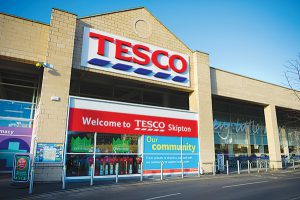Tesco Plc has become the first British food retailer to warn about the impact of the cost-of-living crisis. But it’s worth remembering that inflation — even at a 30-year high of 7% in March — isn’t all bad for grocers.
The company announced a rebound in underlying operating profit in the year to February 2022, up almost 60% to 2.8 billion pounds ($3.6 billion). Profit from its stores rose 35% to more than more than 2.6 billion pounds. Free cashflow also surged by 70%.
But the company cautioned that retail operating profit in the year to February 2023 could stay at 2.6 billion pounds or fall slightly lower to 2.4 billion pounds — a reflection of customers reverting to pre-pandemic habits, the company’s own costs going up and the investment needed to keep its prices competitive. The shares fell as much as 7% in early trading.
Yet Tesco risks being overly pessimistic. While most investors are focused on the detrimental effect of inflation, periods of higher food prices can actually be helpful for supermarkets.
If shelf prices are rising, supermarkets’ sales automatically jump too. As long as customers don’t cut back too much on what they buy, that should lead same-store sales — a measure closely watched by investors — to expand. In contrast, deflation is pernicious. In this type of environment, supermarkets must sell more cans of beans and loaves of bread to reach the same level of sales.
What’s more, as customers’ budgets are squeezed, they may trade dining out for more grocery dinners. Why not choose a meal from Tesco’s premium Finest range instead? Rising gasoline prices may keep more people away from the office and stuck at home, too. US supermarket operators, including Albertsons Cos and Kroger Co, have recently reported improving sales trends amid higher prices and consumers continuing to eat at home. Earlier this month, Bank of America upgraded Kroger because it would be a beneficiary from customers spending more.
In the UK, food-price inflation hit 5.2% in March, the highest since April 2012, according to data provider Kantar.
The danger is that this goes higher amid supply-chain disruption from the war in Ukraine and consumers start to buy less, trade down or defect to the discount supermarkets Aldi Ltd and Lidl Ltd. The budget stores are already regaining momentum after losing customers to big-box rivals during the pandemic.
Tesco is matching Aldi’s prices on about 650 product lines, which should help
it retain customers. As Britain’s biggest food retailer, it should also have more clout with suppliers to get the best deals. And it is in the fortunate position that two of its biggest rivals, Asda Group Ltd and Wm Morrison Supermarkets Ltd, are in private hands. Thanks to large borrowings taken on to fund their buyouts, those two may be less able to slash their own prices.
I’ve argued before that Tesco should go further with its price cuts. Amid the cost-of-living crisis, it has a once-in-a-lifetime opportunity to weaken Asda and Morrison, as well as its listed competitor J Sainsbury Plc. Tesco Chief Executive Officer Ken Murphy shouldn’t squander his chance.
—Bloomberg
Andrea Felsted is a Bloomberg Opinion columnist covering the
consumer and retail industries. She previously worked at the Financial Times
 The Gulf Time Newspaper One of the finest business newspapers in the UAE brought to you by our professional writers and editors.
The Gulf Time Newspaper One of the finest business newspapers in the UAE brought to you by our professional writers and editors.

